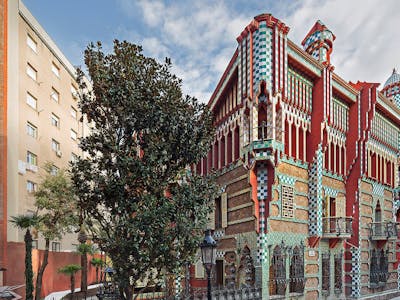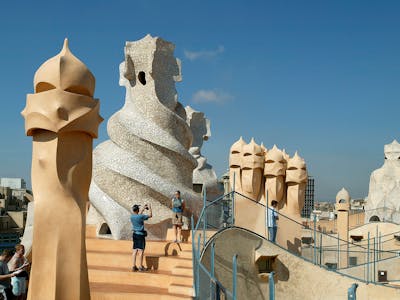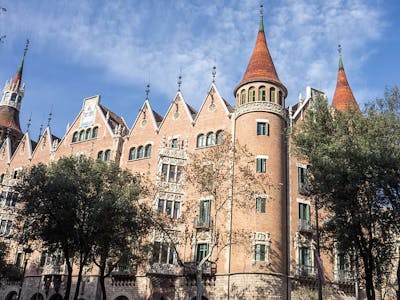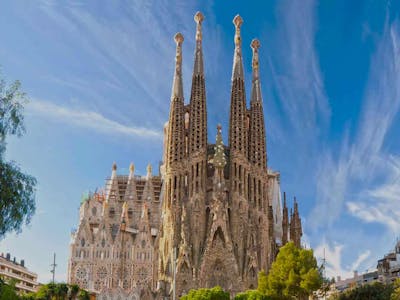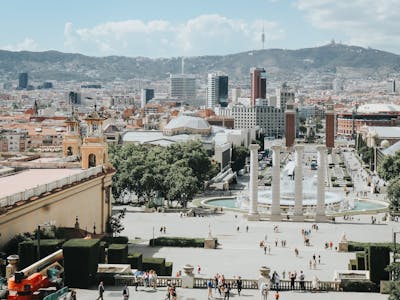Antoni Gaudí's imaginative designs graced Catalonia with stunning Art Nouveau and Modernism-influenced monuments and buildings. Casa Batlló, also known as Casa dels ossos (House of Bones) locally, stands as a UNESCO World Heritage Site showcasing Gaudí's unique style and vision. Originally a modest classical structure housing Lluis Sala Sánchez, it underwent a transformation in 1904 by the seasoned architect.
Built in 1875, the house changed ownership in 1900 when textile industrialist Josep Batlló I Casanovas acquired it for its prime location on Passeig de Gracia, a prestigious address in early 20th-century Barcelona. After marrying Amalia Godo Belaunzaran, Batlló and his wife enlisted Gaudí to infuse the building with his iconic flair, turning it into a landmark of the city.
Know before you go
Things to know
Number of visitors per year: 1 million
UNESCO World Heritage Site designation: 2005
Established: 1912
Architect: Antoni Gaudi
Architectural style: Modernisme, Modern architecture, Expressionist architecture
Opening Hours And Address
Daily 9am to 8pm
Last Entry at 7pm
Address : Passeig de Gràcia, 43, 08007 Barcelona, Spain
Get Directions
Casa Batlló recommended tickets
You can also grab City Cards. They let you visit many famous spots in Barcelona easily. One big perk is skipping lines at most sights and museums. You can book it a day ahead and use it for seven days starting from when you buy it. Plus, it lets you skip lines at Casa Batlló too!
Best time to visit Casa Batlló
Barcelona is a magnet for tourists year-round. To dodge the crowds, consider visiting in January or February for a quieter experience. During peak tourist season, aim for early morning, afternoon (during siesta), or late night visits to Casa Batlló for easier exploration and to appreciate its beauty.
Learn more about the best time to visit Casa Batlló and the city itself, with our guide to the best time to visit Barcelona.
Why visit Casa Batlló
Casa Batlló in Barcelona is a must-see spot due to its distinctive design and historical significance. The building itself is remarkable as it stands sturdy without internal supports or external reinforcements, thanks to its balanced structure. Its exterior, adorned with trencadís and skull-shaped balconies, gives a glimpse of the intriguing interiors. Inside, the underwater theme, reflecting Gaudí’s love for nature, gives the house a dreamlike vibe. The absence of straight lines and angles creates a fluidity reminiscent of the sea, visible in the ceiling, windows, and tiled walls.
The house is bathed in natural light, featuring circles, waves, and spirals throughout. Exploring the Noble floor reveals the grandeur of past celebrations under the swirling hall ceiling. Climbing the four flights of stairs reveals wavy windows, ornate chandeliers, and a unique blue-green tiled terrace with distinctive chimneys.
Casa Batlló stands out as a focal point in Barcelona's architecture, showcasing the Batlló family's life in its mezzanine. The nature-inspired exterior with ivory balconies and colorful glass fragments is captivating. Inside, every aspect, from the beautiful oak staircase to the bright central courtyard, paints a vivid picture of Gaudí's artistic era. The rooftop, resembling dragon scales, features unique curved chimneys, a signature of Casa Batlló's charm.
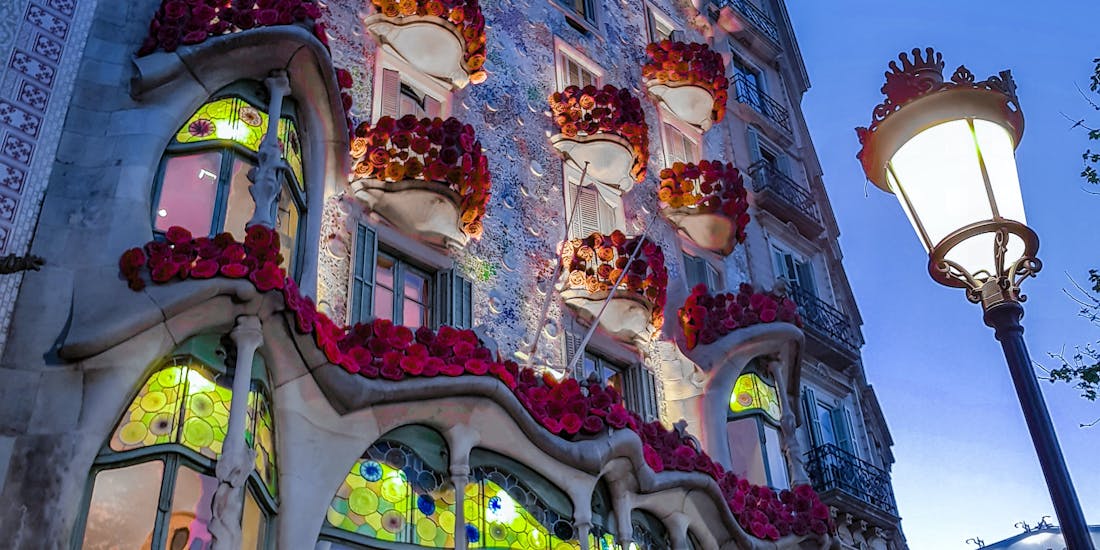
What not to miss at Casa Batlló
- Entrance Hallway and the Central Staircase: As you enter the house, you'll step into a marine-inspired setting. The entrance hallway blends horizontal and vertical lines that curve at the ceiling, showcasing Casa Batlló's unique architecture. Moving forward, the striking central staircase takes you to the Planta Noble, once home to the Batlló family.
- The Noble Hall and the Courtyard: Planta Noble, or the Noble Hall, forms the main floor. The dining room, adorned in wood and glass, exudes grandeur with its triple arcade. This space hosted lavish gatherings for the Batlló family, offering a view of Paseo de Gracia through its large windows. The 20th Century fireplace adds a historical touch. Walking along the corridor by the Noble Hall, you can glimpse into various rooms.
- The Attic: The Attic, originally a storage area, is a unique experience. Its catenary arch resembles a large animal's ribcage, complemented by bone-colored plastering and lighting from German Ingo Maurer. The Attic's balconies are perfect for photos with the house's façade in the background.
- Pattio De Luces: Pattio De Luces, reached from Planta Noble, is a charming spot. The communal stairwell's ceramic tiles in shades of blue create an optical illusion, enhanced by light from stained windows. Ascending the stairs might make you feel like you're under the sea!
- Terrace and Chimneys: The Terrace, resembling dragon scales in orange, blue, and green, offers a breathtaking view of Barcelona. Its chimneys, decorated with the trencadis mosaic technique, add personality and are popular photo spots, framing Casa Batlló's beauty.
Getting there
- Subway: Passeig de Gràcia: L2, L3 and L4
- Train: RENFE- Passeig de Gràcia station or FGC- Provença station
- Bus: H10, V15, 7, 22, and 24
Casa Batlló is located on Passeig de Gràcia in Barcelona. You have the following public transport options available to get to the museum:
Restaurants near Casa Batlló

A quaint place with shaded sidewalk seating, as well as a bar on the inside, this vibrant restaurant serves traditional Spanish tapas.

Just like the name sugguests, NÜA is a smart restaurant inspired by tech and comes with interactive tables that serves small bites - like tapas - and desserts. It's a great place to visit if you're looking for a one of a kind experience.

A lively, traditional taverna, this restaurant is known for it's Catalonian cuisine as well as a tasting menu. They offer an excellent variety of wine, and the food is moderately priced. The simple yet delicious potato dishes are to die for!

Pizzeria Micaela is perfect for if you are feeling up to some Italian food! With fresh, oven-baked pizzas. Whether you want a whole pizza, or a generously portioned slice, the choice is upto you!
Casa Batlló facts
- Casa Batlló, a renowned creation by Antoni Gaudí, stands proudly as a significant landmark in Barcelona.
- Originally a residence owned by wealthy industrialist Josep Batlló, the building underwent Gaudí's transformative design to enhance its facade and overall appeal.
- Adorned with intricate tile work and mosaics depicting natural themes, including a distinctive dragon-like creature on the roof, Casa Batlló captivates visitors with its artistic charm.
- Exploring inside reveals a captivating array of rooms and spaces that reflect Gaudí's innovative approach to materials, colors, and shapes.
- Despite its popularity among tourists, Casa Batlló remains a functioning home for the Batlló family, meticulously preserved over time.
- Recognized as a UNESCO World Heritage Site and one of the Seven Wonders of Catalan Art, the building holds cultural significance.
- Each year on May 24th, Casa Batlló illuminates in red and yellow lights to mark Saint John's Day, a public holiday in Catalonia.
- In 2014, the building underwent a multi-million euro renovation to restore original features and enhance visitor accessibility, ensuring its legacy endures for generations to come.
Casa Batlló insider tips
- It’s a good idea to buy your tickets online and in advance to enjoy hassle-free entry to the building
- Don’t forget to look at the elevator inside the building- it dates back to the modernism era
- You can use the free WiFi at Casa Batlló to share your photos and videos with the world!
- If you want to avoid the crowd, visit the monument early in the morning or in the afternoon on a weekday
- You can tour the whole building in an hour but if you want to stay on till the closing time (9 PM) to admire Gaudí’s work
- If you find the building crowded, start your tour from the terrace and after spending some time posing with the chimneys, start making your way down
- Casa Batlló at night can be even more magical, and you can be a witness to its beauty by going for an evening concert and become part of ‘Magical Nights’
- If possible, visit Casa Batlló on a sunny day to witness the play of light on the colourful tiles that decorate the terrace and the façade of the house
Things to do nearby
FAQs
What is the best time to go for the Casa Batllo tour?
Is the Casa Batllo open post Covid-19?
How much do the Casa Batllo tickets cost?
Are guided tours available for Casa Batllo?
Is Casa Batllo wheelchair accessible?
Can I take photographs inside Casa Batllo?
Is there a gift shop at Casa Batllo?


